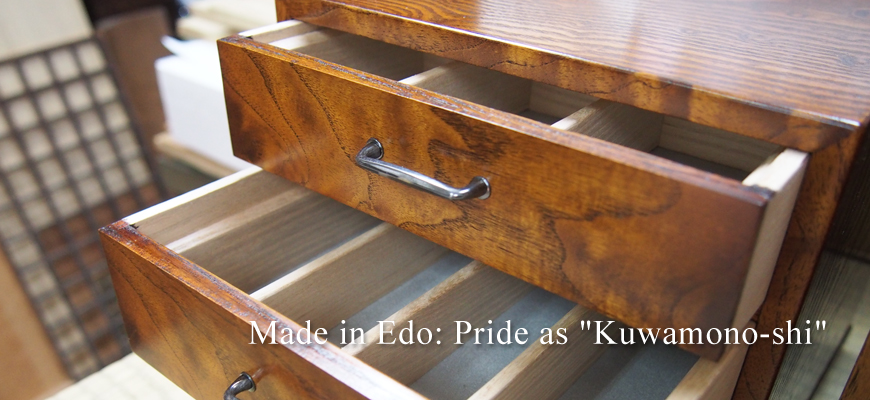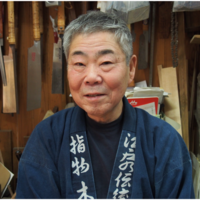
Tadashi Kimura
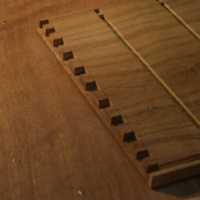
Boards are mortised together by a technique called "Shikuchi."
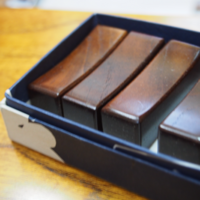
Mulberry-wood from Mikura Island gets tanned as time goes by, and acquires a beautiful deep shine.

Handmade hand mirrors are available in a variety of sizes, which are often bought as gifts by women.
What is Edo-style cabinetwork?
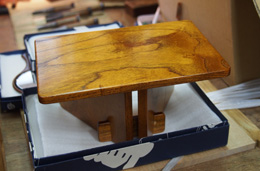
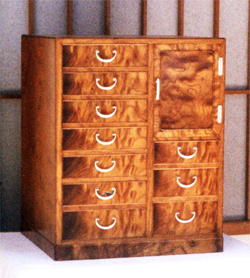
If people take pleasure in using the products, I am also happy.
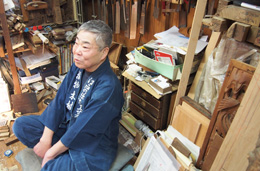
We are called "craftsmen," but we also work for a living. In such a condition, if I receive an order, I take time to carefully make traditional crafts. I am happy If customers use those crafts for a long time and are satisfied with them. If a first-time customer buys a craft at an exhibition or some other places and think it is easy to use, the customer will visit the exhibition again next year. If customers are attracted to the crafts in that way, I find my job rewarding.
How did Kimura become an Edo-style cabinetmaker?
How and when did you become an Edo-style cabinetmaker?
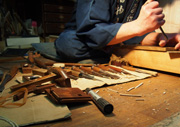
You were thoroughly trained, weren't you?
I thought that I could become independent after 10 years of training, but when I asked my master whether I could be independent or not after 10 years, he asked me to take care of other apprentices for three years, so I took care of the apprentices, thinking that it was a free service for my master. In the past, there was an apprentice system, so if I was told to do so by my master, I should obey my master. Since I was the first apprentice, I took care of younger apprentices on behalf of my master. After serving my apprenticeship for 13 years, I was set up in business by my master.
My master and his wife had good personalities, so I have been able to work as a craftsman. My parents died when I was a child, so I had no one to depend upon. I did jobs for a living at that time. Therefore, I went through both difficult and pleasant times, but I met my master, and wanted to be like him. In accordance with my master's wish, I have worked as a craftsman to this day.
Cabinetwork made of Mulberry-wood from Mikura Island
Cabinetmakers who use Mulberry-wood are called "Kuwamono-shi," aren't they?
In the past, cabinetmakers who used Mulberry-wood were called "Soju-sho." Mulberry-wood from Mikura Island is of the highest quality. In the past, Miyake Island, located next to Mikura Island, had better shipping connections, so Mulberry-wood from Miyake Island was used. Mulberry trees in Miyake Island had continuously been cut down since the Meiji Period, so the Mulberry trees were depleted. It takes 300 to 400 years for Mulberry trees to grow up. Since large ships did not reach Mikura Island for a long period of time, Mulberry trees remained on the island. The ocean around Mikura Island is clear, and abounds with fish, so hundreds of thousands of seabirds fly to the island every year. Those seabirds make their nests, and bring nutriment from fish they eat to the island, so good Mulberry trees gown on the island. Mulberry-wood is definitely the best material for cabinetwork.
Is all Mulberry-wood that you are using from Mikura Island?
I have been linked to Mikura Island by fate. Since the road running around Mikura Island was constructed about 20 years ago, untouched Mulberry trees could be hewed out. When about 50 Mulberry trees from Mikura Island were taken to the lumber market, I bought a significant number of the Mulberry trees. Since then, I was connected to people on Mikura Island. So they have continuously sold Mulberry trees to me. It is the reason I can use Mulberry-wood from Mikura Island.
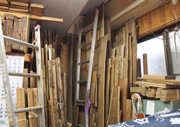
Is this brown wood from Mikura Island?
Mulberry-wood has yellow grain, but if uncoated Mulberry-wood is polished, it turns beautiful brown after a lapse of 40 to 50 years. After all, the color and shine of Mulberry-wood from Mikura Island are different from those of other materials. Mulberry-wood from Mikura Island is beautifully tanned as time goes by. Nowadays, it is rarely taken to the market. People who cut down Mulberry trees get older, and the number of the loggers has decreased. Logging is hard and dangerous job for young people, so they scarcely become loggers. Since roots of Mulberry trees are the most beautiful parts, the trees need to be dug up from the roots, but it is very hard work. It is necessary to lift the tree after digging the ground around the tree, so it is the work that requires a lot of time and effort.
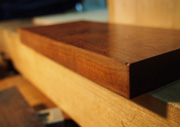
Manufacturing processes
Could you tell me about the manufacturing processes of Edo-style cabinetwork?
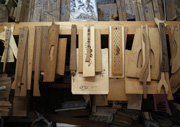
It takes a long time to make cabinetwork, doesn't it?
For a small drawer that I am now making, it takes about two months to complete all processes, including coating process. Therefore, after receiving an order, I make two different products: one for the customer, and the other one for myself. I make a variety of products and put them aside on a routine basis.
Tools
What kind of tools do you use to make cabinetwork?
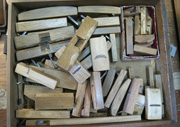
You need as many tools as the number of products, don't you?
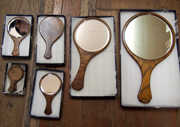
Pride as a craftsman
Could you tell me about a sense of satisfaction as a craftsman?
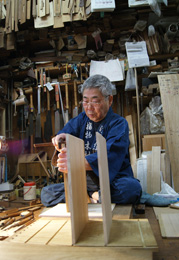
We have held exhibitions every year, so customers have gradually become discerning. Therefore, even if other person makes a cabinet of which shape is copied from my cabinet, it is not sold at a high price. It is a blessing for us because the real stuff is in demand and used by customers. As with human beings, a piece of work reveals a craftsman's personality. Even if a craftsman's name is not written on a piece of work, it is possible to tell who made it. Finally, if customers select and use Edo-style cabinetwork, which I make out of Mulberry-wood from Mikura Island bringing out natural grain of the wood, I feel that my job is worth doing.

Tadashi Kimura

Boards are mortised together by a technique called "Shikuchi."

Mulberry-wood from Mikura Island gets tanned as time goes by, and acquires a beautiful deep shine.
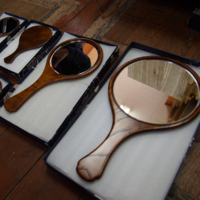
Handmade hand mirrors are available in a variety of sizes, which are often bought as gifts by women.
What is Edo-style cabinetwork?

Edo-style cabinetwork is made with mortise and tenon joints without using metal fittings such as nails. Specialized cabinetmakers have appeared since the Muromachi Period. Edo-style cabinetwork is stylishly made, bringing out grain of wood such as mulberry and paulownia, while elegant Kyto-style cabinetwork is varnished with lacquer. Especially, Mulberry-wood from Mikura Island near the Izu Peninsula is valuable because it has beautiful glossy grain, and craftsmen who can obtain and process the wood are few in number. Products made of Mulberry-wood from Mikura Island get tanned as time goes by, and come to fit comfortably in user's hand. The image (above) shows a stool made by a technique called "Aibiki." Legs of the stool can be removed, so it can be put into a flat box. Heads of schools of Kabuki buy the stools in bulk because samisen players use it.

A jewel box
Handles are made of silver.
If people take pleasure in using the products, I am also happy.

We are called "craftsmen," but we also work for a living. In such a condition, if I receive an order, I take time to carefully make traditional crafts. I am happy If customers use those crafts for a long time and are satisfied with them. If a first-time customer buys a craft at an exhibition or some other places and think it is easy to use, the customer will visit the exhibition again next year. If customers are attracted to the crafts in that way, I find my job rewarding.






